Let’s continue to collect those old school D&D threads that I share on twitter!
The Thieves of Fortress Badabaskor, by the Judges Guild staff (1978). This one is a true classic of old school gaming!
Judges Guild, which still does stuff today, got their start as an official licensed producer of D&D products. They lost that license, but continued to put out D&D-friendly supplements for years.
Badabaskor is one of Judges Guild’s most famous products: it is a classic multi-level dungeon crawl, including the history of the fortress and the village within it.
The Fortress itself is described as a former imperial outpost, taken over by an odd combination of bandits and cultists of the god Angall. Being old school D&D, of course, the stats of Angall are given for completeness.
The village of the Fortress, despite being run by bandits, can serve as a base for dungeon exploring (as long as the characters don’t mind the risk of having their wine drugged and being sold into slavery).
The dungeon is quite lovely, consisting of five levels. It’s rather nice to see a cross-section like this that shows how they’re all stacked together.
The dungeon levels themselves are mapped out beautifully, pretty much what Judges Guild is known for.
The encounters themselves? Each room has a very straightforward description. Some of them are more detailed than others. And also, like a lot of early D&D, they are often PACKED with loot.
The original “Thieves” was reprinted four years in a row, from 1978-1981, with a different style of cover for each year.
It was adapted for the 3.5th edition of D&D in 2007, as well!
Why is “Thieves” so endearing? Nothing in particular stood out for me as a “wow!” feature; I think it is just a really excellent early D&D adventure that compared excellently with what TSR was putting out at the time. And it had cool, if random, illustrations!
PS my copy is a 1st edition Badabaskor that I picked up at Games Plus in the Chicago suburbs for a great price. If you’re ever in Mt. Prospect, I HIGHLY recommend visiting them if you’re a gamer. You won’t regret it.
Pillars of Pentegarn (1982), by Rose Estes. Let’s look at one of the works of early Dungeons and Dragons fiction!
Obviously, this book, which was also labeled a “Pick-A-Path Adventure,” uses the same format as classic “Choose Your Own Adventure” books, that exploded in popularity with the first book in 1979.

What I didn’t know is that the Endless Quest books were part of a TSR initiative to develop curriculum programs for reading and problem solving!
If you don’t know the format: the books present the reader with choices at key moments, directing you to different pages depending on your choice. Thus you “pick” a “path” through the book, with different endings possible, some good, some horrific. I still have four of my original Endless Quest books, and I focus on Pillars of Pentegarn because it is the one burned into my brain: it is practically a horror story!
In the book, you “play” as Jaimie, a young boy who can inexplicably talk to animals and hangs out with them in the forest. When his animal friends spot goblins pursuing an adventuring party, he opts to go warn them. (Or not, in which case the story ends immediately!)
In the ruins called the Pillars of Pentegarn, Jaimie meets a wizard, a fighter, and an elven rogue, who have arrived to reclaim the lands for King Pentegarn — the wizard — from the evil Dark One.
This book stands out from other Endless Quest books due to it particularly eerie nature. You are playing a rather vulnerable young person, thrust into a catacombs filled with goblins and horrific undead, including the dracolich on the book’s cover.
I feel comfortable saying that EVERYONE who has read the book has the scene burned into their minds when the rogue scouts ahead, finds some cursed treasure, and returns as an animated skeleton! This is a magnificently horrific scene.
I did a quick reread through Pillars just to remind myself of the story and see how I would fare, and I’m delighted to say that I got probably the best ending on the first try! (I would’ve been traumatized if I had skeletonized Lydia again.)
The book is early enough in D&D history that it doesn’t have any particular setting. That’s part of the charm for me: there’s no huge Forgotten Realms lore and backstory to worry about, just a boy, his talking fox and owl friends, and an evil Dark One.
Reading it was a great nostalgia trip, and I will probably dig through the others I own eventually, too!
PS somehow I only now just learned that TSR also published a series of “HeartQuest” books, D&D stories with romance, aimed and young women! Now I need to read one…
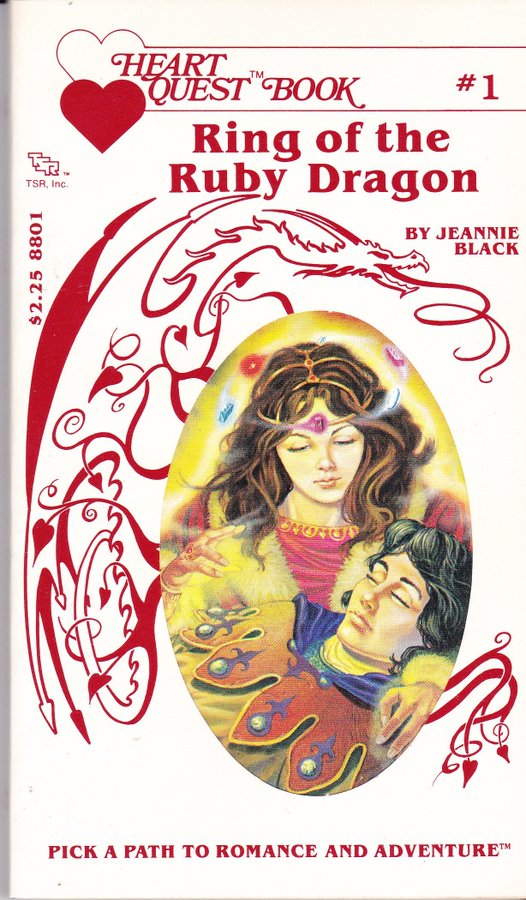
Gods, Demi-Gods & Heroes (1976), by Robert Kuntz and James Ward. Time for one of the true classics of zeroth edition Dungeons and Dragons!
This book was the fourth and final supplement to the original “0th edition” D&D rules. It starts with a pretty amusing foreword by the editor. One of the rare times I know of that an editor admits “loathing” the project they worked on!
Curiously, the latter part of the foreword shows that the book was designed to address another early problem in D&D: power “Monty Haul” gamers! Basically: “Here are the stats of literal gods. If your characters are more powerful, you’re doing something wrong.”

The book literally just dives right into gods. We have the Egyptian pantheon to start…
Including Ptah, who is described as the “God of Outer Space,” a description I’ve never heard before but I dig it.
Then the book rolls right into the gods of India, something that didn’t stick around for later editions, for good reason, considering people still follow this religion.

And then onto the Celtic gods…

Odin gets a LOT of detail, including his weaponry. I love the editorial decision to allow an exclamation point to highlight the *10* arrow attacks, which admittedly is quite a few!
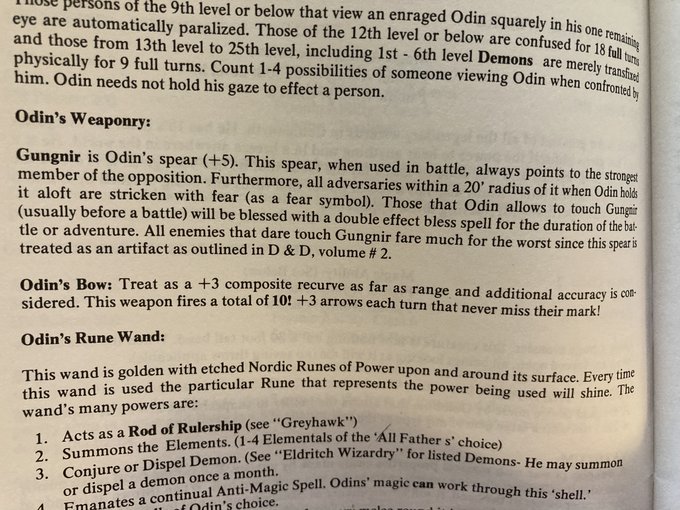
The Finnish gods have something wild: they can move at *infinite* speed. I assume there’s something in Finnish folklore that this is based on, but it’s the only time I’m aware of “infinity” being an official stat.
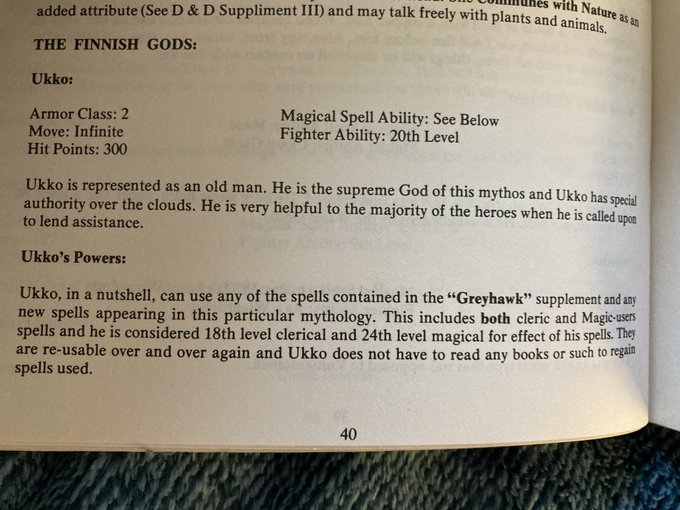
It was a bit of fun nostalgia for me to see the minor Finnish gods, because my very first D&D cleric worshipped Loviatar (from Deities and Demigods), which was admittedly a random choice.

This book possessed something that the later Deities and Demigods would not: the gods and lore of Robert E. Howard’s Hyborea, including Conan!
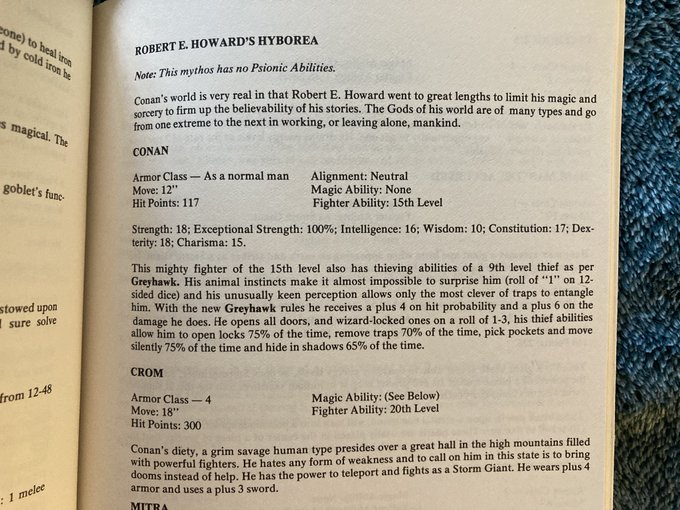
The Hyborean section includes lots of details on characters and magic from the Conan stories, including this character from the classic “Tower of the Elephant.”
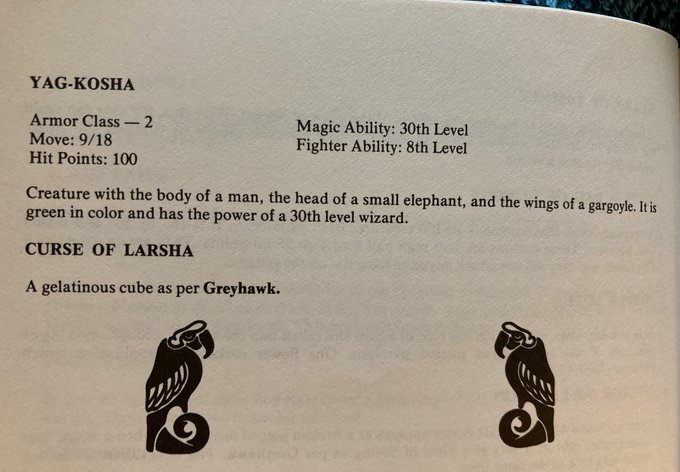
GD&H also included the Elric pantheon, with stats for Elric. Famously, these would be removed from later editions of Deities and Demigods because TSR didn’t want to promote competitor Chaosium’s games and stories.
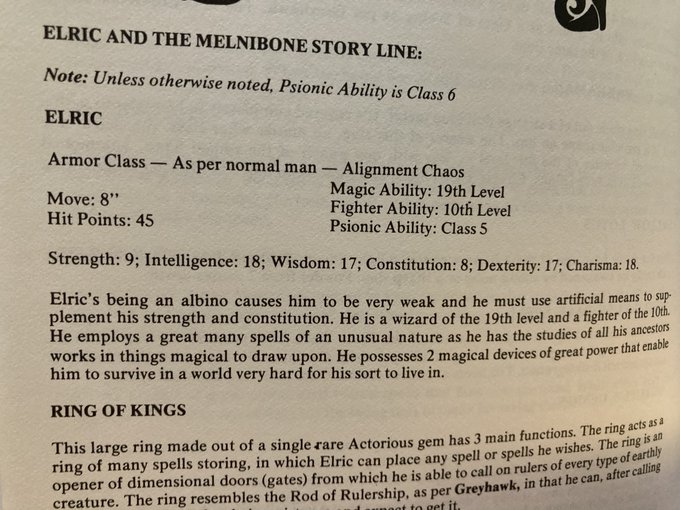
After this, we have the Mexican and Central American mythos…
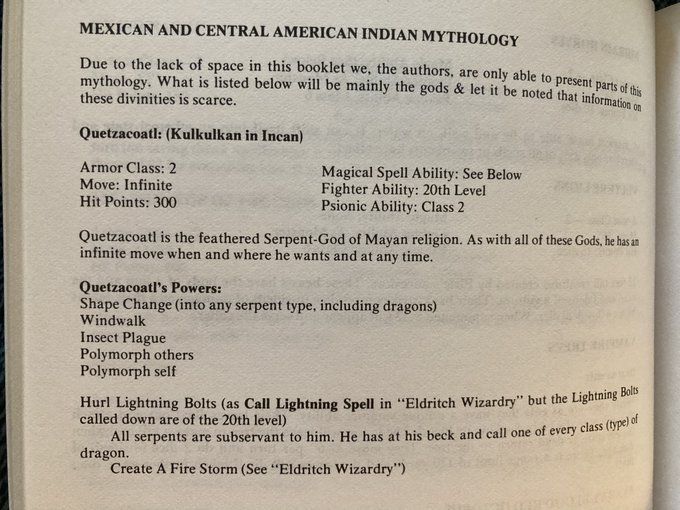
The book wraps up with a description of Eastern mythos, and ends just as abruptly as it began. It really is just a list of stats!
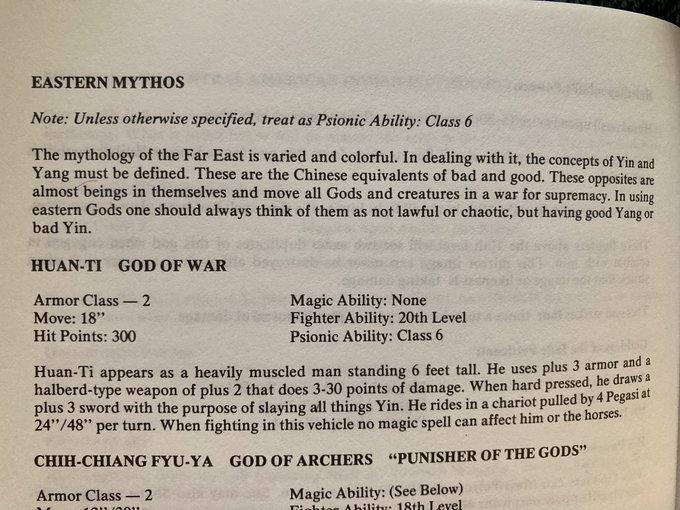
This book would be replaced with the 1e Deities and Demigods, which most people are more familiar with! But that is another story…
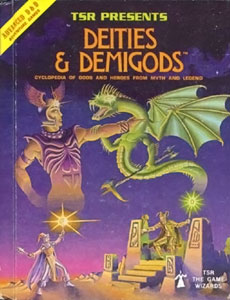
Shipwrecker (1983), by Sue Stone. Shipwrecker is another product of Mayfair Games’ Role Aids line, which printed unauthorized D&D adventures. Many of these were surprisingly good and imaginative, though there were a lot of uninspiring ones, too (same for TSR, though).

Shipwrecker is one of a small number of women-authored D&D adventures from the early days. Another, Palace of the Silver Princess (1980), written by Jean Wells, was withdrawn from the market and replaced with a male-authored version soon after publication.
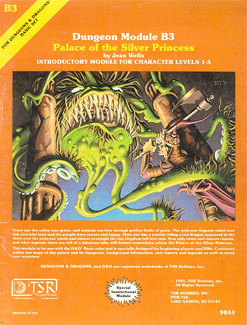
So what is Shipwrecker about? This adventure for mid-level characters centers on recovering a golden chalice stolen by pirates. The adventurers start in a small coastal town and proceed through goblin caves to the pirate caves.
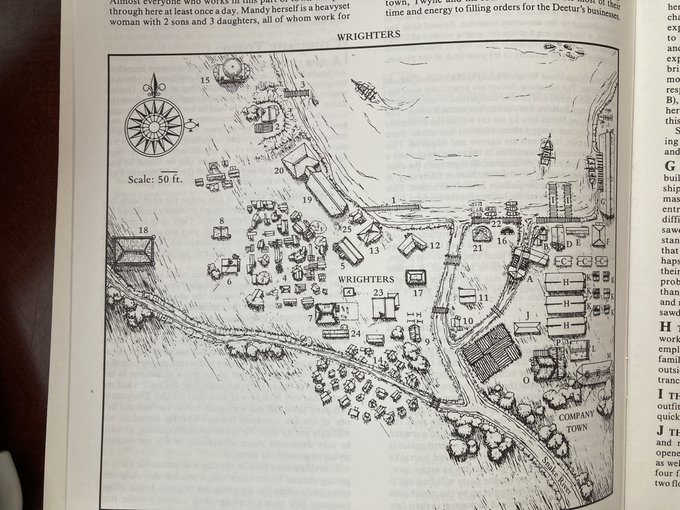
The town is a company logging town, and is well described, including some very detailed NPCs who can be used as PCs if needed.
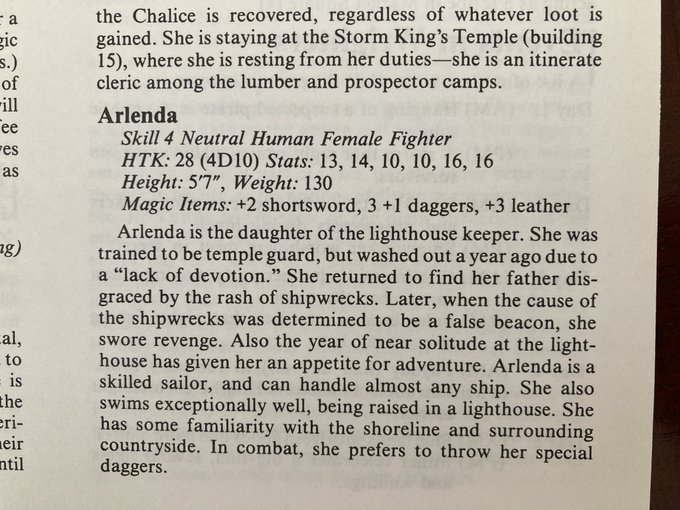
After either brawling with the goblins or negotiating with them, the players can find the well-hidden entrance to the pirate caves. It is a nice 3 level dungeon.

Overall, there isn’t much that stands out in the dungeon, but I enjoyed this description of a pirate illusiionist’s ready-made spell scrolls.
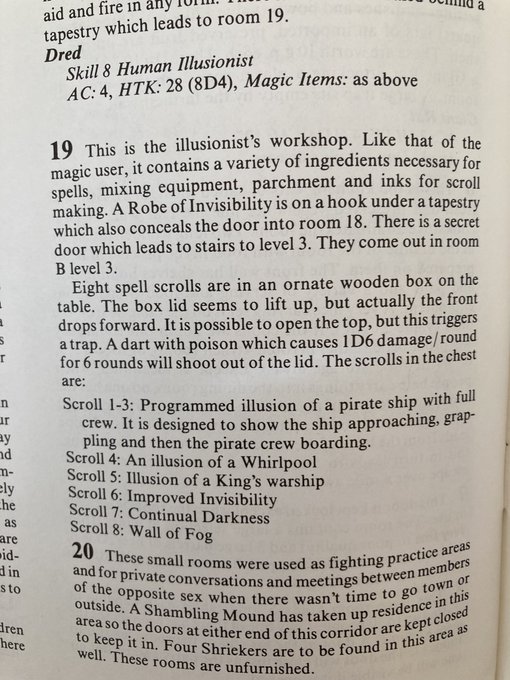
One curious thing about the pirate caverns: they’re *really* well hidden, even for the Dungeon Master! I scanned the book several times and couldn’t clearly figure out where the entrance from the goblin caves actually is hidden! I found it a curious design flaw in the module.
Shipwrecker really has the same feel as The Keep on the Borderlands — an adventure that features a well-described home base along with several perilous caves to explore.
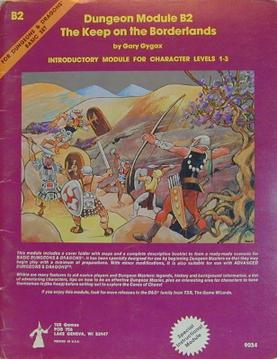
So why “Shipwrecker?” That’s the name of the local chaotic sea god (goddess?) said to be responsible for the large number of shipwrecks in the area. However, the deity doesn’t actually appear in the adventure, so the title is a bit misleading!
PS it should be noted that Shipwrecker has really fleshed out descriptions of the history of the area and its denizens, something that was pretty uncommon in the early D&D module days.
Okay, that’s it for this edition of old school Dungeons & Dragons! More in the future!



















Reblogged this on DDOCentral.